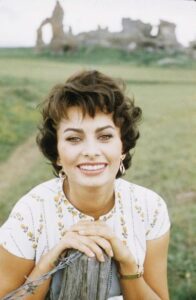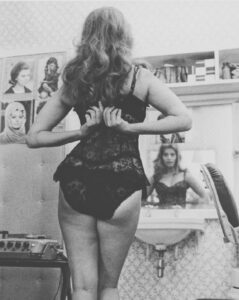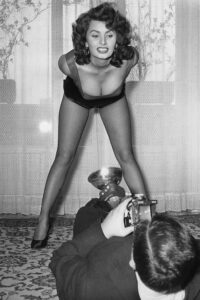To television viewers of the mid-1970s, fans knew her as Sgt. “Pepper” Anderson; to her friends, while growing up in LaMoure County, she was known as Angie Brown; but to her millions of fans in North Dakota and the rest of the world, she is known with great affection as Angie Dickinson.
From 1954 to 2004, she had major roles in over 50 motion pictures as well as hundreds of television episodes. Dickinson was initially noted for her beauty, but also developed into an outstanding actress, winning a Golden Globe Award for Best Actress for her continuing role on the popular television series, “Police Woman.” She was nominated four times for Primetime Emmy Awards as “Outstanding Lead Actress in a Drama Series” on television and won the Saturn Award for Best Actress in the movie “Dressed to Kill.”
Besides publishing the newspaper, Leo was also the projection operator for the movies in Kulm, which were shown in a large room in city hall. Angie and her sisters loved watching the movies and after each film, the girls would often reenact the roles of the characters.
Unfortunately, Leo had a serious drinking problem and was forced to sell the Messenger in 1936. In 1938, the Browns moved 15 miles northeast to Edgeley where Leo purchased the Edgeley Mail newspaper. Once again he was the projection operator until the theater burned down in 1941. Angie and her sisters were so upset that they no longer had motion pictures to watch, “they cried for a week.”
Once again, Leo’s excessive drinking forced him to sell his newspaper, and the family relocated to Burbank, Calif., in 1942. Burbank was the home of the Lockheed Aircraft Corp. during the military buildup of the early stages of World War II, and employment opportunities were plentiful.
Angie attended Bellarmine-Jefferson High School, a co-educational Catholic high school that had just been built. She was a straight-A student and won the Sixth Annual Bill of Rights essay contest. Angie graduated at the age of 15 in 1947 and took courses at Glendale Community College and Immaculate Heart College in Los Angeles.
In 1950, Angie went to work at a parts factory at the Lockheed Air Terminal and, in August of 1951, began dating Gene Dickinson, a college football star. The two were married on June 2, 1952, and in 1953, Gene encouraged his wife to enter the local Miss America contest. That exposure got the attention of a television industry producer, “who asked her to consider a career in acting.” Angie followed his advice and studied acting and then “appeared on a TV show called ‘Beauty Parade’ in which she won the competitions of the week, the month, and finally for the year.”
This led to a role on the “Colgate Comedy Hour,” hosted by comedian Jimmy Durante. His guest on that show was Frank Sinatra and Angie knew at that moment that show business was her calling. She later said, “That was it. This is for me.” In that episode, aired on Feb. 21, 1954, Angie appeared as a commercial model.
Later that year, Angie appeared on three episodes of “Death Valley Days” and had minor roles on “I Led Three Lives” and “The Mickey Rooney Show.” She also made her first motion picture appearance, as a party guest, in the Doris Day film “Lucky Me.”
In 1955, Angie appeared in over a dozen television shows, often in featured roles, and had minor roles in two Western motion pictures. She was a frequent actress on “Matinee Theater,” a television series in which Marcia Henderson, who later lived in West Fargo, was one of the stars.
By 1956, Angie was becoming one of the most active major actresses on television, and she also appeared as the lead actress in a motion picture. In the film “Gun the Man Down,” she played the role of the unfaithful girlfriend of James Arness, who starred on the popular television show “Gunsmoke.” The movie was produced by Robert E. Morrison, the brother of John Wayne.
Throughout the 1950s, almost all of the movies that Dickinson appeared in were Westerns, as well as many television series including “Have Gun Will Travel,” “Wagon Train,” “Gunsmoke,” “Wyatt Earp,” “Broken Arrow,” “Cheyenne,” “Tombstone Territory,” and “Colt .45.”
In 1959, Angie got her first big break in movies when she was given the lead female role in the John Wayne film “Rio Bravo.” In the movie, Angie played a flirtatious gambler called Feathers who is attracted to the town sheriff, played by Wayne. She said that Wayne had been her “childhood idol,” and that she needed to be very careful when talking to him about politics on the set because he was a staunch Republican and she was a Democrat.
One of Angie’s good friends at the time was the famed economist John Kenneth Galbraith, an active Democrat who had served in the presidential administrations of Franklin Roosevelt and Harry Truman. He had also taught economics at Harvard where one of his prize students and friends was U.S. Sen. John F. Kennedy. One of the other stars in “Rio Bravo” was Dean Martin, and Dickinson knew she had him as a pol
itical ally.
By 1960, Angie was recognized as not only one of Hollywood’s glamour queens, but an up-and-coming major actress. She was awarded the Golden Globes’ “New Star Actress of the Year” in 1960. With her fame, her marriage to Gene Dickinson had fallen apart, and they got divorced. However, as an actress, she did retain his last name.
Also in 1960, John F. Kennedy won the Democratic primary, making him the party’s presidential candidate. A group of entertainers known as the Rat Pack threw their support to him and actively campaigned for him. Frank Sinatra was considered the leader of the pact and other members included Dean Martin, Sammy Davis Jr., Joey Bishop and Peter Lawford. Lawford was Kennedy’s brother-in-law.
In 1960, they all appeared together in the movie “Ocean’s 11,” and Sinatra chose Angie to play his wife, the female lead, in the movie. After the movie was completed, Sinatra and Angie began going out together. Because she was invited to attend Kennedy’s Inauguration Ball, rumors circulated that Angie and the new president were involved in a relationship, something that Angie has always denied.


 Entertainment1 year ago
Entertainment1 year ago
 Entertainment1 year ago
Entertainment1 year ago
 Entertainment1 year ago
Entertainment1 year ago
 Entertainment1 year ago
Entertainment1 year ago
 Entertainment1 year ago
Entertainment1 year ago
 Entertainment1 year ago
Entertainment1 year ago
 Entertainment1 year ago
Entertainment1 year ago
 Entertainment1 year ago
Entertainment1 year ago























